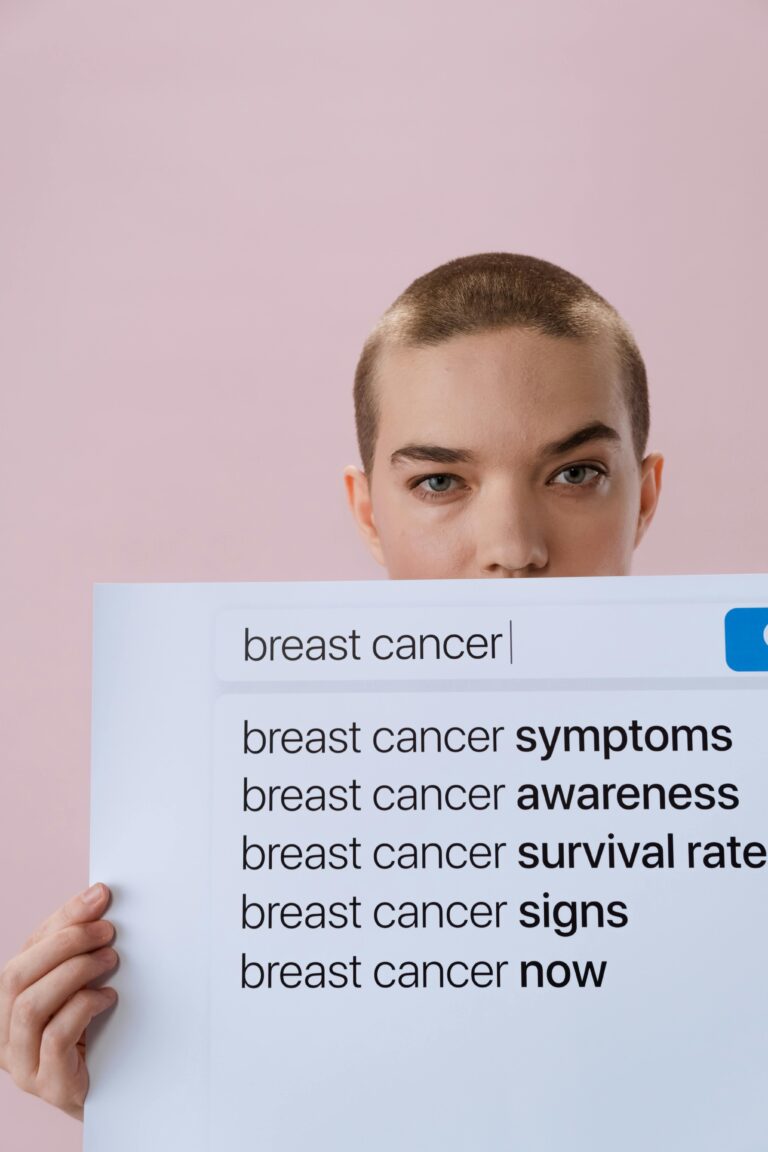
Although it affects both men and women, breast cancer is much more common in women. It is one of the most common malignancies in the world. It is an illness that starts in the breast cells, where tumors develop as a result of aberrant cell proliferation. Both benign (non-cancerous) and malignant (cancerous) tumors are possible. The biology, causes, prevention techniques, diagnostic methods, available treatments, and the psychological and emotional effects on patients will all be covered in this article.
Global health initiatives like “Breast Cancer Awareness Month” and advancements in medical research have contributed to a notable increase in breast cancer awareness in recent years. But even with these advancements, breast cancer is still a serious health risk, especially for women over 40. From risk factors and early detection to treatment options and patient emotional support, this article will explore the many facets of breast cancer.
What is Breast Cancer?
Definition and Types of Breast Cancer
Breast cancer arises when the proliferation of breast cells becomes unchecked. Normally, the body’s cells divide and grow in a controlled manner, but when breast cells divide rapidly and exhibit abnormalities, a tumor may form. Tumors can be either benign (non-cancerous) or malignant (cancerous). Because malignant tumors have a tendency to spread to other parts of the body, they are dangerous.
There are two primary types of breast cancer:
The non-invasive cancer known as ductal carcinoma in situ (DCIS) is characterized by aberrant cells that are located in the milk ducts but have not migrated to the surrounding tissue.
IDC, or invasive ductal carcinoma, is the most prevalent kind of breast cancer. After starting in the milk ducts, it moves on to the surrounding tissue.
Invasive lobular carcinoma, inflammatory breast cancer, and uncommon varieties such angiosarcoma are among the additional forms of breast cancer.
How Breast Cancer Develops
Genetic alterations in breast cells lead to the development of breast cancer. These mutations may be brought on by environmental factors, inherited genes, or lifestyle choices. These mutations usually impact genes like the BRCA1 and BRCA2 genes that regulate cell division and proliferation. The chance of getting breast cancer rises when these genes are altered.
The lobules, which are glands that produce milk, and the ducts, which transport milk to the nipple, are two areas of the breast where breast cancer can arise. The surrounding tissue, including lymph nodes, which aid in the body’s fluid drainage, may also be impacted.
Risk Factors for Breast Cancer
Genetic Factors
Although hereditary factors can raise the risk, the majority of breast cancer cases are not directly inherited. A person’s risk of getting breast cancer is greatly increased by mutations in genes such as BRCA1 and BRCA2. These genes are in charge of fixing damaged DNA, but when they are altered, they might not be able to do so, which could result in the development of malignant cells.
A higher risk of breast cancer has also been associated with other genetic abnormalities, including those involving TP53, PTEN, and CHEK2.
Family History and Heredity
You may be more susceptible to breast cancer if you have a mother, sister, or daughter who has had the condition. Women are more likely to get breast cancer themselves if they have several family members who have had the disease, especially when they were young.
Hormonal Factors
The development of breast cancer is significantly influenced by hormones. Breast cancer risk may rise with prolonged exposure to progesterone and estrogen. Among the elements that raise hormone exposure are:
- Menstruation that begins before the age of twelve
• Late menopause, which occurs after age 55.
• Hormone replacement treatment (HRT), particularly for long-term use
It has been demonstrated that nursing and pregnancy lower the risk of breast cancer. Breastfeeding for a longer period of time and having children earlier may reduce the risk of breast cancer.
Lifestyle Factors
Certain lifestyle choices can contribute to an increased risk of breast cancer:
- Alcohol Use: Drinking alcohol raises your risk of getting breast cancer, especially if you consume excessive amounts of it.
- Diet and Obesity: Because fatty tissue produces more estrogen, being overweight or obese raises the risk, especially after menopause.
- Physical Inactivity: One established risk factor for breast cancer is a lack of regular physical activity.
Age and Gender
As people age, their risk of developing breast cancer rises. Women over 50 receive the majority of breast cancer diagnoses, and the disease’s prevalence increases with age. Although males can get breast cancer, they only account for around 1% of all occurrences of the disease.
Signs and Symptoms of Breast Cancer
Based on the disease’s kind and stage, breast cancer can exhibit a variety of symptoms. Typical symptoms and indicators include:
Lump in the Breast or Underarm
One of the most typical indicators of breast cancer is a lump or mass in the breast. Although lumps are frequently painless, physical examinations and imaging studies can identify them.
Changes in Breast Shape or Size
One breast may alter size or shape as a result of breast cancer. This might happen slowly or quickly.
Skin Changes
The breast’s skin may be puffy, red, or dimpled. This can be a sign of inflammatory breast cancer, an uncommon and severe kind of the disease.
Nipple Changes
Breast cancer may be indicated by changes in the nipple, such as inversion (the nipple turning inward), discomfort, or discharge (other than breast milk).
Pain
Despite the fact that breast cancer is not usually painful, some women may feel discomfort in their breasts, particularly if the cancer is aggressive or has spread.

Early Detection and Diagnosis
For breast cancer to be successfully treated, early detection is essential. Breast cancer can be identified and diagnosed using a variety of techniques.
Mammography
The most used method of breast cancer screening is mammography. It helps identify cancers that are too small to be felt by producing an image of the breast tissue using low-energy X-rays. Women over 40 are advised to get regular mammograms.
Ultrasound
In addition to mammography, breast ultrasonography is frequently used to further assess breast abnormalities. It is especially helpful for differentiating between fluid-filled cysts and solid tumors.
Biopsy
A biopsy is frequently carried out to determine whether the tissue is malignant if an anomaly is found. During a biopsy, a tiny sample of tissue is taken from the suspicious location and inspected under a microscope.
MRI (Magnetic Resonance Imaging)
High-risk patients or those with dense breast tissue, which can reduce the effectiveness of mammograms, are frequently candidates for MRI. Strong magnets and radio waves are used in an MRI to produce finely detailed images of the breast.
Genetic Testing
Genetic testing to check for BRCA1, BRCA2, and other genetic abnormalities may be advised for women with a high family history of breast cancer.
Treatment Options for Breast Cancer
The kind and stage of breast cancer, the patient’s age, and general health are some of the variables that affect treatment. The most popular forms of treatment consist of:
Surgery
The initial line of treatment for breast cancer is frequently surgery. Removing the tumor or the entire breast tissue is the aim of surgery. Surgery comes in a variety of forms:
- Lumpectomy: The tumor and a tiny amount of surrounding tissue are removed.
- A mastectomy involves removing all of the breast tissue. This can be either a modified radical mastectomy, which removes the breast along with some surrounding lymph nodes, or a total mastectomy, which removes the entire breast.
Radiation Therapy
High-energy rays are used in radiation therapy to target and kill cancer cells. In order to eradicate any cancer cells that may still be present and lower the chance of recurrence, it is usually done following surgery.
Chemotherapy
Drugs are used in chemotherapy to either kill or slow the growth of cancer cells. It can be used to reduce tumor size prior to surgery (neoadjuvant therapy) or to eradicate any cancer cells that may still be present after surgery (adjuvant therapy). Usually, invasive breast cancer that has spread is treated with chemotherapy.
Hormone Therapy
Cancers that are hormone receptor-positive—that is, those need hormones like estrogen to grow—are treated with hormone therapy. Drugs like tamoxifen and aromatase inhibitors that block estrogen or reduce its levels in the body are examples of hormone treatments.
Targeted Therapy
Targeted therapies function by focusing on particular chemicals that contribute to the proliferation of cancer cells. The goal of these treatments is to eliminate cancer cells with the least amount of harm to healthy cells. One medication used to treat breast cancer that tests positive for the HER2 receptor is called Herceptin.
Immunotherapy
Immunotherapy stimulates the immune system to identify and combat cancerous cells. Although it is still in its infancy, this area of breast cancer treatment has promise, particularly for triple-negative breast cancer.
Living with Breast Cancer
The emotional and psychological impact of receiving a breast cancer diagnosis can be profound. It can be extremely difficult for people to deal with the diagnosis, go through therapy, and get used to the new normal. Having the emotional support of friends, family, and medical professionals is crucial.
Support Groups
Patients can interact with others going through similar struggles and share their experiences in a secure environment during support groups. Breast cancer patients can use information from numerous organizations, such as the American Cancer Society, to locate support groups.
Mental Health
During breast cancer treatment, mental health management is essential. Stress, anxiety, and sadness can all affect a patient’s quality of life. Counseling and psychosocial support can aid in addressing these issues.
Life After Treatment
Following treatment for breast cancer, individuals may have long-term consequences include mental distress, tiredness, or lymphedema (swelling). To keep an eye out for any indications of recurrence, routine follow-up treatment is crucial.
Precautions for Preventing Breast Cancer
Breast cancer cannot be completely prevented, however there are a number of preventative measures and lifestyle modifications that can lower the chance of getting the disease. In order to avoid breast cancer, proactive health decisions, early detection, and awareness are essential. The following are some crucial safety measures and preventative techniques:
Regular Screening and Early Detection
Frequent screening is one of the most crucial ways to avoid breast cancer. Early detection can save lives and improve the likelihood of a successful course of therapy.
- Breast Self-Examination (BSE): While no longer universally recommended for all women, self-examinations can help women become familiar with the normal texture of their breasts and notice any unusual changes or lumps. If any changes are noticed, it’s important to see a healthcare provider immediately.
It is advised that women over 40 get regular mammograms, or sooner if there is a family history of breast cancer. The most popular and efficient screening method for identifying early indicators of breast cancer is mammography. - Breast Self-Examination (BSE): While no longer universally recommended for all women, self-examinations can help women become familiar with the normal texture of their breasts and notice any unusual changes or lumps. If any changes are noticed, it’s important to see a healthcare provider immediately.
- Breast Self-Examination (BSE): BSE can help women learn about the natural texture of their breasts and spot any lumps or anomalies, but it is no longer recommended for all women. Consult a medical expert immediately if any changes are noticed.
- Clinical Breast Exams: As part of a routine examination, a medical professional may do a clinical breast exam. For women who might not be able to conduct a self-examination or who are worried about the health of their breasts, this is especially crucial.
Maintain a Healthy Weight
Obesity, particularly after menopause, raises the risk of breast cancer due to increased estrogen production by fatty tissue. Maintaining a healthy weight through a balanced diet and regular exercise can aid in hormone regulation and lower the chance of getting breast cancer.
- Regular physical activity promotes good weight management, improves general health, and lowers the risk of breast cancer. Aim for 30 minutes of moderate activity most days of the week.
- A balanced diet with fruits, vegetables, whole grains, and lean proteins can prevent weight gain and reduce inflammation in the body. Consuming healthy fats, such as those found in nuts, seeds, and salmon, can also help protect heart health.
Limit Alcohol Consumption
There is significant evidence that alcohol intake increases the risk of breast cancer. The more alcohol a woman consumes, the greater her chances of having breast cancer.
- Alcohol and Estrogen: Alcohol increases estrogen levels in the body, which can stimulate the growth of hormone-receptor-positive breast cancer cells. Limiting alcohol helps minimize estrogen exposure.
• Limiting alcohol: intake is one of the most effective ways to reduce breast cancer risk. It is recommended that ladies limit their alcohol consumption to one drink each day. The danger decreases as one consumes less alcohol. - Alcohol and Estrogen: Higher estrogen levels can promote the growth of hormone-receptor-positive breast cancer cells. Limiting alcohol use reduces estrogen exposure.
Avoid Hormone Replacement Therapy (HRT) for Extended Periods
A higher risk of breast cancer has been associated with hormone replacement therapy (HRT), which is frequently used by women to treat menopausal symptoms. Long-term use of hormone replacement treatment, particularly combination estrogen and progesterone therapy, increases the risk of breast cancer.
- Consult with Healthcare Providers: Women who are thinking about taking hormone replacement therapy should speak with their doctors about the advantages and disadvantages of the treatment. Menopause symptoms may be managed with short-term HRT use, but long-term use needs to be carefully considered.
- Alternative Therapies: Non-hormonal methods of treating menopausal symptoms, like vaginal moisturizers for dryness or selective serotonin reuptake inhibitors (SSRIs) for hot flashes, should be taken into account.
Breastfeeding
Long-term breastfeeding is thought to have preventative benefits against breast cancer. According to studies, a woman’s chance of getting breast cancer later in life decreases with the length of time she breastfeeds.
- Breastfeed for at least six months, but any period can be beneficial. Longer breastfeeding periods may reduce the risk of hormone-related cancers by lowering estrogen exposure over time.
Genetic Testing and Family History
The risk of breast cancer is significantly influenced by family history. You might be more vulnerable if you have a close relative with breast cancer, such as a mother, sister, or daughter. Furthermore, the risk of breast cancer can be considerably increased by hereditary gene mutations such as BRCA1 and BRCA2.
- Genetic Testing: To look for BRCA mutations, think about getting tested if you have a high family history of breast cancer. You might be able to take preventive actions, such more frequent tests, lifestyle changes, or even preventive operations (like mastectomy or oophorectomy), if a mutation is discovered.
- Regular Monitoring: In addition to mammograms, more regular tests like MRI may be advised for women who are at increased risk because of family history or genetic mutations.

FAQs about Breast Cancer
1. What is breast cancer?
One kind of cancer that starts in the breast cells is called breast cancer. Although it is much more common in women, it can happen to men as well. If not identified and treated promptly, it can spread to other areas of the body after usually starting in the milk ducts or lobules.
2. What are the main types of breast cancer?
There are several types of breast cancer, but the two most common are:
Ductal Carcinoma In Situ (DCIS): A non-invasive cancer known as ductal carcinoma in situ (DCIS) occurs when aberrant cells are discovered in the milk ducts but have not yet migrated to neighboring tissue.
Invasive Ductal Carcinoma (IDC): The most prevalent kind of breast cancer, invasive ductal carcinoma (IDC), begins in the milk ducts and spreads to nearby tissue. Invasive lobular carcinoma, inflammatory breast cancer, and uncommon varieties such angiosarcoma are among the other types.
3. What are the main risk factors for breast cancer?
Several factors can increase the risk of breast cancer, including:
- Gender: Compared to men, women have a much higher risk of breast cancer.
• Age: Risk rises with age, particularly after the age of fifty.
• Family History: The risk may be raised if you have close relatives who have breast cancer.
• Genetics: BRCA1 and BRCA2 gene mutations can raise risk.
• Hormone Replacement Therapy (HRT): Using HRT over an extended period of time may raise your risk.
• Lifestyle: Drinking alcohol, being overweight or obese, and not exercising are all linked to an increased risk.
4. Can men get breast cancer?
Yes, although it is far less common in men, breast cancer can still strike them. Even though the breast tissue in men is less developed, cancer can nonetheless grow there. Approximately 1% of all cases of breast cancer are in men.
5. How is breast cancer diagnosed?
Breast cancer is diagnosed through a combination of:
- Mammograms: A regular breast X-ray examination, particularly advised for women over 40.
• Ultrasound: An imaging procedure that establishes whether a breast lump is solid or filled with fluid.
• Biopsy: A technique where a tiny sample of breast tissue is taken out and examined for cancerous cells.
• MRI (Magnetic Resonance Imaging): Used for more detailed images or in some high-risk individuals.
• Clinical Breast Exam: A physical examination performed by a medical professional to check for breast changes or lumps.